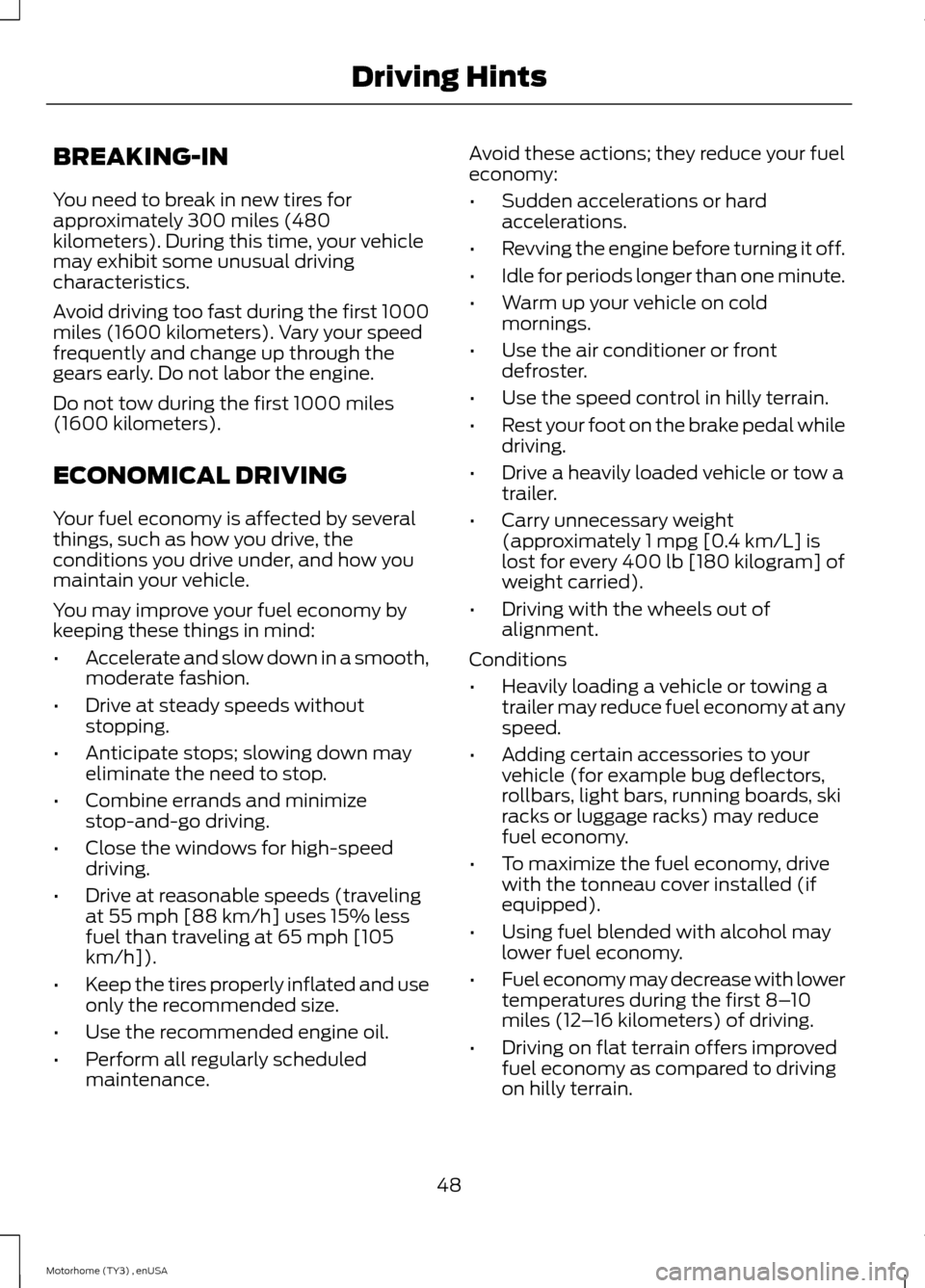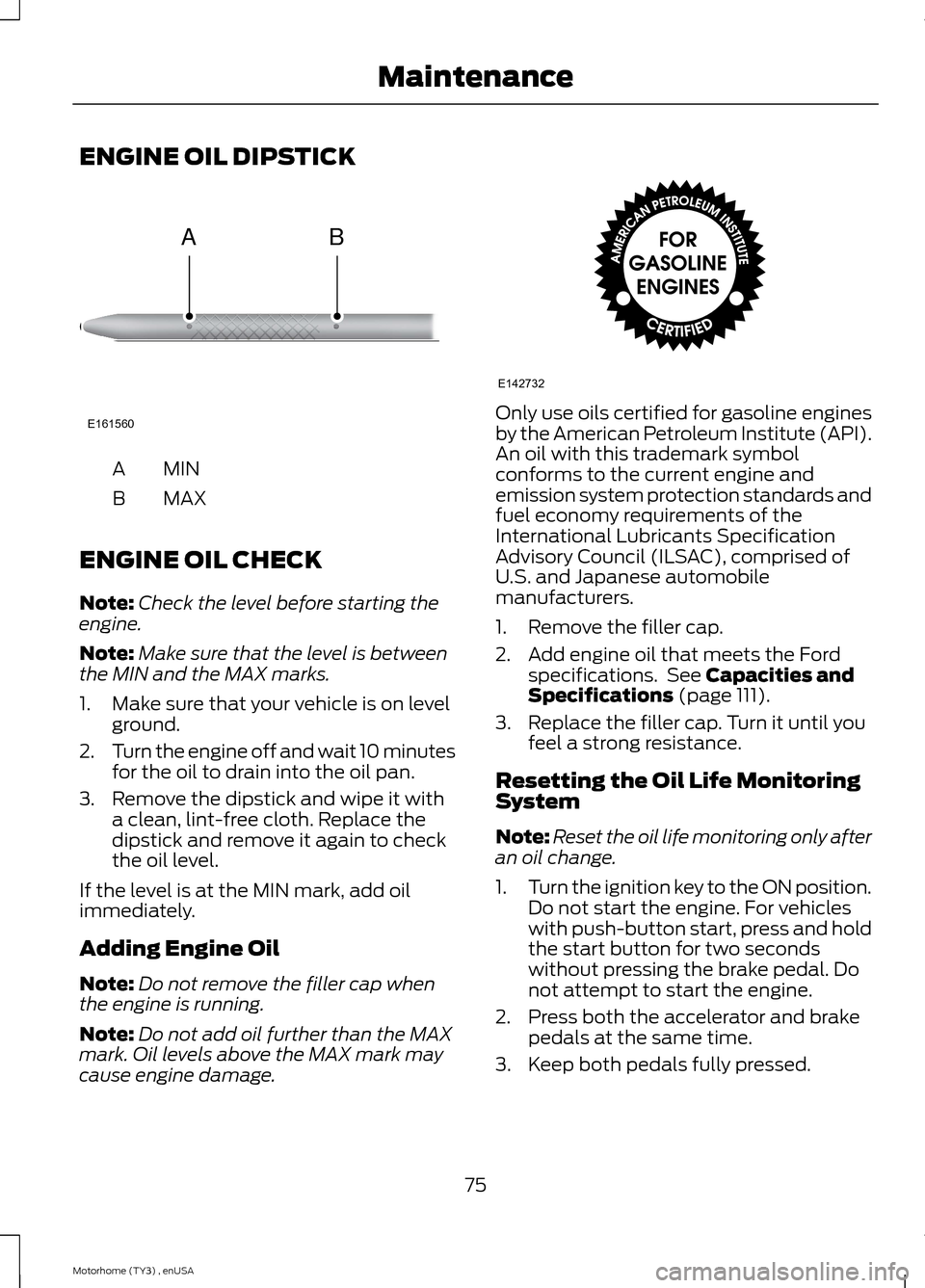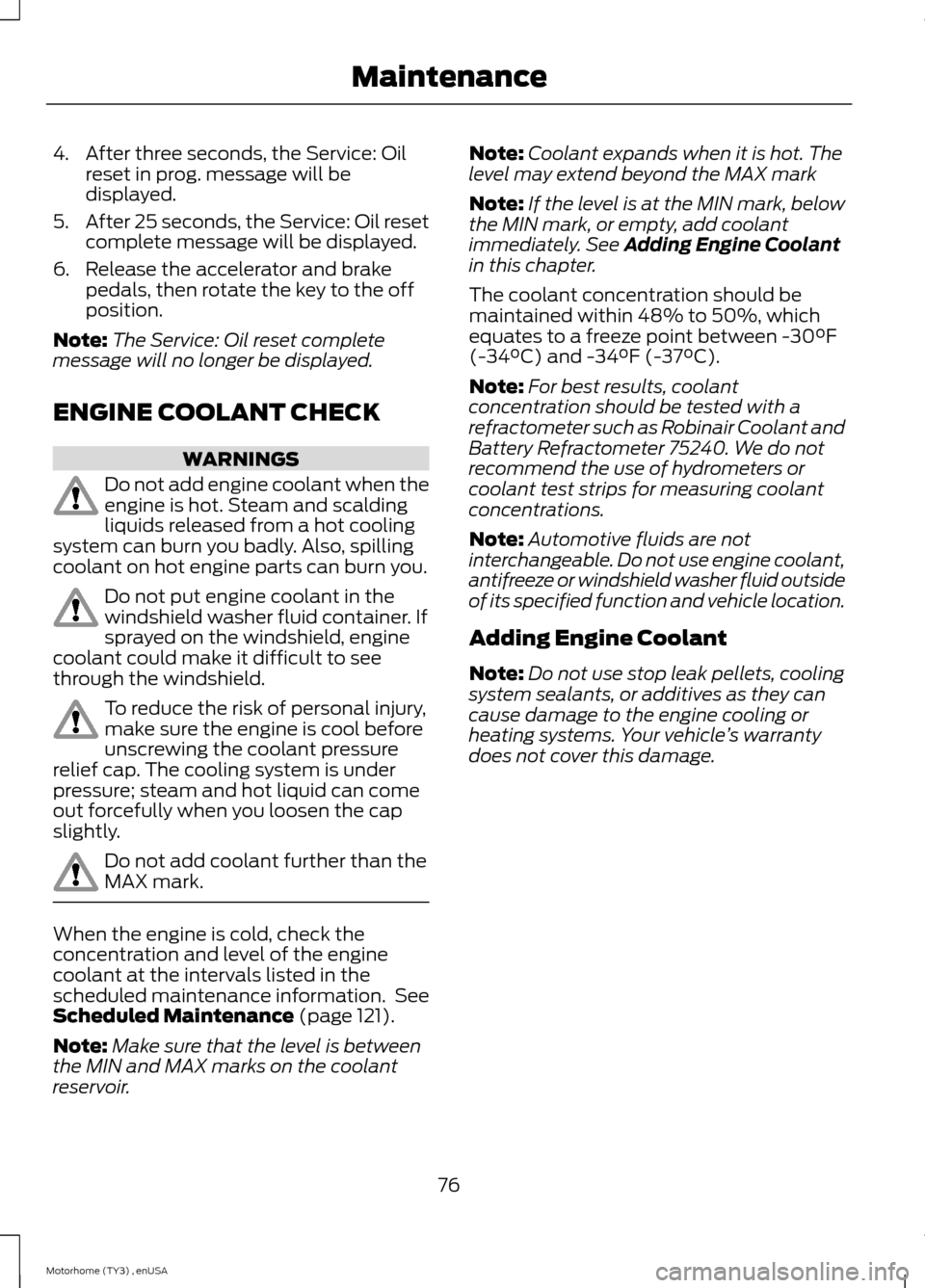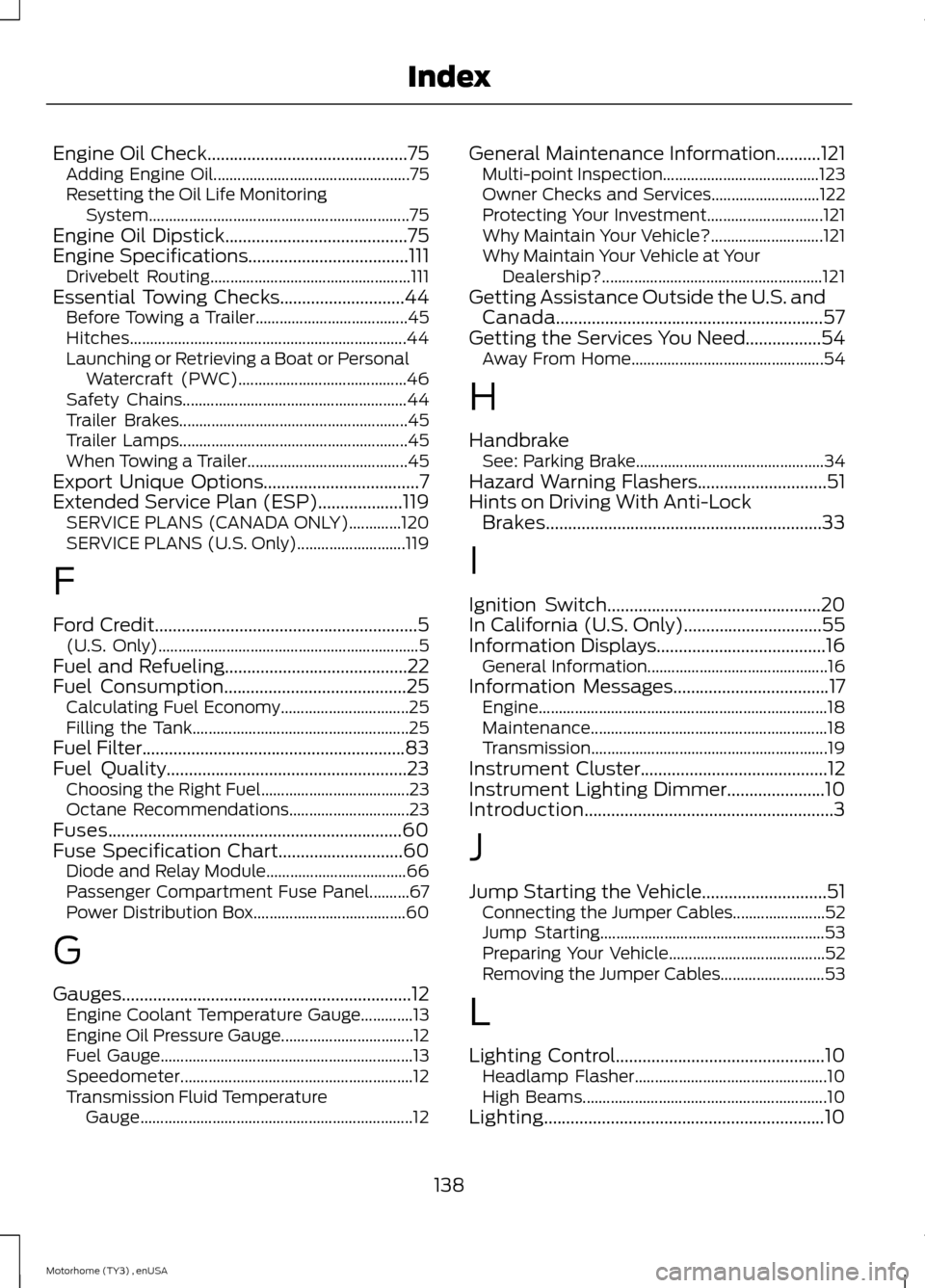2014 FORD F SERIES MOTORHOME AND COMMERCIAL CHASSIS adding oil
[x] Cancel search: adding oilPage 51 of 143

BREAKING-IN
You need to break in new tires forapproximately 300 miles (480kilometers). During this time, your vehiclemay exhibit some unusual drivingcharacteristics.
Avoid driving too fast during the first 1000miles (1600 kilometers). Vary your speedfrequently and change up through thegears early. Do not labor the engine.
Do not tow during the first 1000 miles(1600 kilometers).
ECONOMICAL DRIVING
Your fuel economy is affected by severalthings, such as how you drive, theconditions you drive under, and how youmaintain your vehicle.
You may improve your fuel economy bykeeping these things in mind:
•Accelerate and slow down in a smooth,moderate fashion.
•Drive at steady speeds withoutstopping.
•Anticipate stops; slowing down mayeliminate the need to stop.
•Combine errands and minimizestop-and-go driving.
•Close the windows for high-speeddriving.
•Drive at reasonable speeds (travelingat 55 mph [88 km/h] uses 15% lessfuel than traveling at 65 mph [105km/h]).
•Keep the tires properly inflated and useonly the recommended size.
•Use the recommended engine oil.
•Perform all regularly scheduledmaintenance.
Avoid these actions; they reduce your fueleconomy:
•Sudden accelerations or hardaccelerations.
•Revving the engine before turning it off.
•Idle for periods longer than one minute.
•Warm up your vehicle on coldmornings.
•Use the air conditioner or frontdefroster.
•Use the speed control in hilly terrain.
•Rest your foot on the brake pedal whiledriving.
•Drive a heavily loaded vehicle or tow atrailer.
•Carry unnecessary weight(approximately 1 mpg [0.4 km/L] islost for every 400 lb [180 kilogram] ofweight carried).
•Driving with the wheels out ofalignment.
Conditions
•Heavily loading a vehicle or towing atrailer may reduce fuel economy at anyspeed.
•Adding certain accessories to yourvehicle (for example bug deflectors,rollbars, light bars, running boards, skiracks or luggage racks) may reducefuel economy.
•To maximize the fuel economy, drivewith the tonneau cover installed (ifequipped).
•Using fuel blended with alcohol maylower fuel economy.
•Fuel economy may decrease with lowertemperatures during the first 8–10miles (12–16 kilometers) of driving.
•Driving on flat terrain offers improvedfuel economy as compared to drivingon hilly terrain.
48Motorhome (TY3) , enUSADriving Hints
Page 78 of 143

ENGINE OIL DIPSTICK
MINA
MAXB
ENGINE OIL CHECK
Note:Check the level before starting theengine.
Note:Make sure that the level is betweenthe MIN and the MAX marks.
1.Make sure that your vehicle is on levelground.
2.Turn the engine off and wait 10 minutesfor the oil to drain into the oil pan.
3.Remove the dipstick and wipe it witha clean, lint-free cloth. Replace thedipstick and remove it again to checkthe oil level.
If the level is at the MIN mark, add oilimmediately.
Adding Engine Oil
Note:Do not remove the filler cap whenthe engine is running.
Note:Do not add oil further than the MAXmark. Oil levels above the MAX mark maycause engine damage.
Only use oils certified for gasoline enginesby the American Petroleum Institute (API).An oil with this trademark symbolconforms to the current engine andemission system protection standards andfuel economy requirements of theInternational Lubricants SpecificationAdvisory Council (ILSAC), comprised ofU.S. and Japanese automobilemanufacturers.
1.Remove the filler cap.
2.Add engine oil that meets the Fordspecifications. See Capacities andSpecifications (page 111).
3.Replace the filler cap. Turn it until youfeel a strong resistance.
Resetting the Oil Life MonitoringSystem
Note:Reset the oil life monitoring only afteran oil change.
1.Turn the ignition key to the ON position.Do not start the engine. For vehicleswith push-button start, press and holdthe start button for two secondswithout pressing the brake pedal. Donot attempt to start the engine.
2.Press both the accelerator and brakepedals at the same time.
3.Keep both pedals fully pressed.
75Motorhome (TY3) , enUSAMaintenanceE161560AB E142732
Page 79 of 143

4.After three seconds, the Service: Oilreset in prog. message will bedisplayed.
5.After 25 seconds, the Service: Oil resetcomplete message will be displayed.
6.Release the accelerator and brakepedals, then rotate the key to the offposition.
Note:The Service: Oil reset completemessage will no longer be displayed.
ENGINE COOLANT CHECK
WARNINGS
Do not add engine coolant when theengine is hot. Steam and scaldingliquids released from a hot coolingsystem can burn you badly. Also, spillingcoolant on hot engine parts can burn you.
Do not put engine coolant in thewindshield washer fluid container. Ifsprayed on the windshield, enginecoolant could make it difficult to seethrough the windshield.
To reduce the risk of personal injury,make sure the engine is cool beforeunscrewing the coolant pressurerelief cap. The cooling system is underpressure; steam and hot liquid can comeout forcefully when you loosen the capslightly.
Do not add coolant further than theMAX mark.
When the engine is cold, check theconcentration and level of the enginecoolant at the intervals listed in thescheduled maintenance information. SeeScheduled Maintenance (page 121).
Note:Make sure that the level is betweenthe MIN and MAX marks on the coolantreservoir.
Note:Coolant expands when it is hot. Thelevel may extend beyond the MAX mark
Note:If the level is at the MIN mark, belowthe MIN mark, or empty, add coolantimmediately. See Adding Engine Coolantin this chapter.
The coolant concentration should bemaintained within 48% to 50%, whichequates to a freeze point between -30°F(-34°C) and -34°F (-37°C).
Note:For best results, coolantconcentration should be tested with arefractometer such as Robinair Coolant andBattery Refractometer 75240. We do notrecommend the use of hydrometers orcoolant test strips for measuring coolantconcentrations.
Note:Automotive fluids are notinterchangeable. Do not use engine coolant,antifreeze or windshield washer fluid outsideof its specified function and vehicle location.
Adding Engine Coolant
Note:Do not use stop leak pellets, coolingsystem sealants, or additives as they cancause damage to the engine cooling orheating systems. Your vehicle’s warrantydoes not cover this damage.
76Motorhome (TY3) , enUSAMaintenance
Page 141 of 143

Engine Oil Check.............................................75Adding Engine Oil.................................................75Resetting the Oil Life MonitoringSystem.................................................................75Engine Oil Dipstick.........................................75Engine Specifications....................................111Drivebelt Routing..................................................111Essential Towing Checks............................44Before Towing a Trailer......................................45Hitches.....................................................................44Launching or Retrieving a Boat or PersonalWatercraft (PWC)..........................................46Safety Chains........................................................44Trailer Brakes.........................................................45Trailer Lamps.........................................................45When Towing a Trailer........................................45Export Unique Options...................................7Extended Service Plan (ESP)...................119SERVICE PLANS (CANADA ONLY).............120SERVICE PLANS (U.S. Only)...........................119
F
Ford Credit...........................................................5(U.S. Only).................................................................5Fuel and Refueling.........................................22Fuel Consumption.........................................25Calculating Fuel Economy................................25Filling the Tank......................................................25Fuel Filter...........................................................83Fuel Quality......................................................23Choosing the Right Fuel.....................................23Octane Recommendations..............................23Fuses..................................................................60Fuse Specification Chart............................60Diode and Relay Module...................................66Passenger Compartment Fuse Panel..........67Power Distribution Box......................................60
G
Gauges.................................................................12Engine Coolant Temperature Gauge.............13Engine Oil Pressure Gauge.................................12Fuel Gauge...............................................................13Speedometer..........................................................12Transmission Fluid TemperatureGauge....................................................................12
General Maintenance Information..........121Multi-point Inspection.......................................123Owner Checks and Services...........................122Protecting Your Investment.............................121Why Maintain Your Vehicle?............................121Why Maintain Your Vehicle at YourDealership?.......................................................121Getting Assistance Outside the U.S. andCanada............................................................57Getting the Services You Need.................54Away From Home................................................54
H
HandbrakeSee: Parking Brake...............................................34Hazard Warning Flashers.............................51Hints on Driving With Anti-LockBrakes..............................................................33
I
Ignition Switch................................................20In California (U.S. Only)...............................55Information Displays......................................16General Information.............................................16Information Messages...................................17Engine........................................................................18Maintenance...........................................................18Transmission...........................................................19Instrument Cluster..........................................12Instrument Lighting Dimmer......................10Introduction........................................................3
J
Jump Starting the Vehicle............................51Connecting the Jumper Cables.......................52Jump Starting........................................................53Preparing Your Vehicle.......................................52Removing the Jumper Cables..........................53
L
Lighting Control...............................................10Headlamp Flasher................................................10High Beams.............................................................10Lighting...............................................................10
138Motorhome (TY3) , enUSAIndex